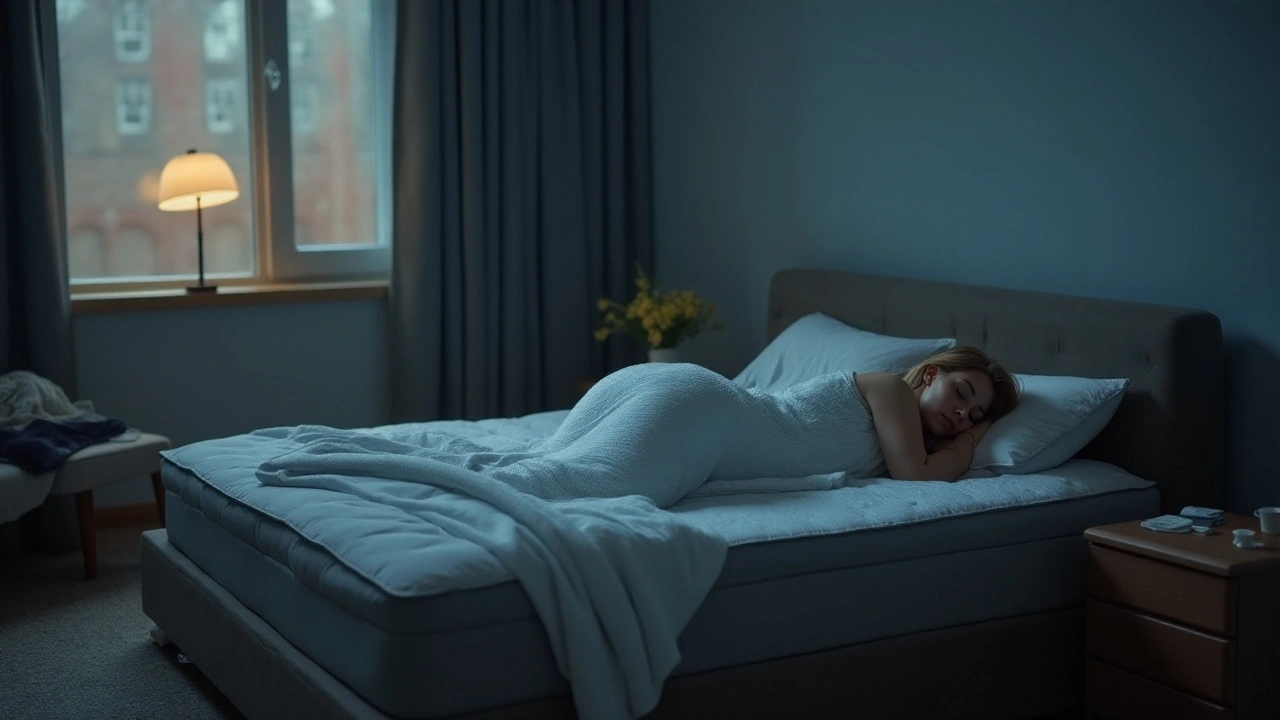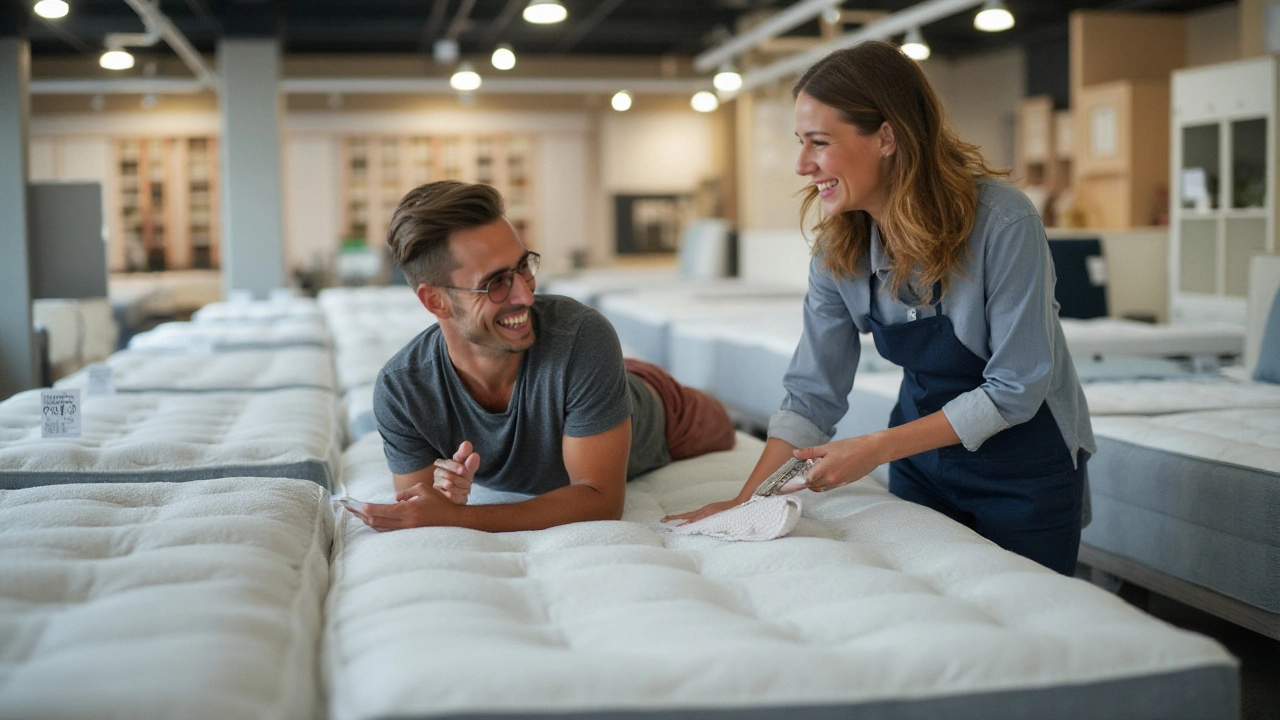When looking for ways to reduce muscle aches, many people overlook how much the right mattress can help. The wrong mattress can aggravate pain, while the right one can be a game-changer for your sleep and overall comfort.
Understanding the different types of mattresses available, from memory foam to innerspring, is a good place to start. Each type offers distinct benefits, so knowing what works best for muscle aches can save you from waking up sore.
Your sleep position and the mattress firmness play crucial roles. People who sleep on their sides need different support compared to back or stomach sleepers. The mattress firmness should align with your sleeping habits to provide the right support.
Before making a decision, it's beneficial to test out mattresses in person. Spending a few minutes lying on different models can give you a better sense of what feels comfortable. Don’t be shy about spending some time in the store; your muscles will thank you later.
Look for key features that contribute to pain relief, such as adequate support and pressure relief. High-quality materials and good construction can also enhance the quality of your sleep, helping to reduce muscle aches.
- Understanding Mattress Types
- Firmness Levels and Sleep Positions
- Trying Out Mattresses
- Key Features for Pain Relief
Understanding Mattress Types
When shopping for a mattress to ease muscle aches, it's important to know the different options available. Each mattress type has its own unique benefits and understanding these can help in making an informed decision that improves your sleep quality and reduces muscle pain.
Let's start with memory foam mattresses. These are known for their ability to contour to the body, providing excellent pressure relief. Memory foam can evenly distribute weight, making it a good choice for people with muscle aches. It's especially beneficial for side sleepers, as it helps cushion the shoulders and hips. However, some people find memory foam retains heat, although newer models often include cooling features.
"Memory foam mattresses tend to offer excellent pressure relief by conforming to the unique shape of the sleeper's body," says Dr. Michael Breus, a clinical psychologist and sleep doctor.
Next, there are innerspring mattresses, which are the most traditional type of mattress. They feature a coil support system and offer a range of firmness options. Innerspring mattresses provide a bouncier feel and generally have good breathability due to the space between coils. They can be a good pick for back and stomach sleepers who benefit from a firmer surface. However, if not paired with a cushiony top layer, they may not provide the same level of pressure relief as other types.
Hybrid mattresses combine the best features of memory foam and innerspring mattresses. They typically have a layer of pocketed coils for support and one or more layers of foam for comfort. These mattresses offer balanced support and pressure relief, making them versatile for different types of sleepers. Hybrids can be an excellent choice if you suffer from muscle aches, as they often provide the contouring support of memory foam with the breathable, supportive structure of innerspring coils.
Latex mattresses are another option worth considering. Made from either natural or synthetic rubber, these mattresses are known for their durability and support. Latex has a responsive feel and provides good bounce, making it a suitable choice for combination sleepers who change positions throughout the night. Latex also naturally retains less heat, which helps keep you cool. For those concerned with environmental impact, natural latex is a more eco-friendly option.
Lastly, there are adjustable air mattresses. These come with air chambers whose firmness can be adjusted based on personal preference. They offer customizable support, which can be particularly beneficial for couples with different firmness preferences or for individuals whose needs change over time.
Overall, the right mattress can greatly affect your muscle aches. By understanding these various types, you can make a choice tailored to your specific needs, leading to better rest and less pain.

Firmness Levels and Sleep Positions
One of the most important factors to consider when choosing a mattress for reducing muscle aches is the firmness level. The right firmness can provide the support your body needs to alleviate pressure points and maintain proper spinal alignment.
Let’s start with those who sleep on their side, which is the most common sleeping position. Side sleepers often require a mattress with a softer surface to cushion their shoulders and hips. This helps in maintaining the natural curve of the spine. A too-firm mattress can create pressure points and lead to morning stiffness.
Back sleepers need a different type of support to ensure their spine remains in a neutral position. They often do best with a medium-firm mattress. This provides just enough give to accommodate the natural curvature of the lower back while supporting the upper body to avoid any sagging. Proper support here is crucial for preventing lower back pain.
On the other hand, stomach sleepers face a different set of challenges. A firmer mattress is generally recommended for them to keep their hips from sinking too far in, which can cause an unnatural arch in the spine. This helps in avoiding both lower back pain and neck pain, which are common complaints among stomach sleepers.
The weight and body type of a sleeper can also influence the ideal mattress firmness. Heavier individuals may find better support from a firmer mattress, which prevents them from sinking in too deeply. Conversely, lighter individuals might prefer a softer mattress to allow for better contouring and comfort. According to a study by the National Sleep Foundation, choosing the right mattress can improve sleep quality significantly, thereby reducing muscle pain.
Sleep quality is inherently connected to the right level of firmness for your mattress. A consistent lack of support can contribute to muscle strain and aches over time. For those who are unsure about their perfect firmness level, many manufacturers now offer adjustable mattresses where the firmness can be modified based on personal preference.
"Selecting the appropriate mattress firmness based on your sleeping position is essential for maintaining spinal health and reducing muscle pain," says Dr. Michael Breus, a well-known sleep expert.
Don’t forget that any mattress you choose will require a break-in period. It’s not uncommon for your body to take a few weeks to adjust to a new mattress. Also, consider that your needs may change over time due to factors like age and health conditions, making it useful to periodically reassess your mattress needs.

Trying Out Mattresses
When it comes to finding the right mattress for reducing muscle aches, testing it out in person is crucial. Spending time on different types of mattresses can give you a much clearer idea of what will offer the best relief. Many stores encourage this, so take your time and be thorough. Don't just sit on the edge; lie down in your usual sleep position and stay there for a few minutes. Feel for any pressure points or discomfort. You’re looking for a mattress that feels supportive yet comfortable.
One key tip is to wear comfortable clothing when shopping for a mattress. This might seem minor, but tight or stiff clothing can distract from how the mattress feels. Imagine testing a high-quality memory foam mattress, but you can't relax because your jeans are pinching your waist. You won’t get a true sense of how it feels. Opt for something you’d normally wear to sleep, like a tracksuit or loose pants.
Sometimes, you may even encounter a sleep expert at the store. They can provide valuable insights into which type of mattress might best suit your needs. According to the Better Sleep Council, “trying out a mattress in-store is like test-driving a car. You wouldn't buy a car without seeing how it handles on the road, and your mattress shouldn't be any different.” It's good advice to follow, especially if you’re investing in a mattress that promises to improve your quality of sleep.
Consider the store's return policy as well. Even after a thorough test, it’s possible the mattress might not feel as good after a few nights’ sleep. Many retailers offer a trial period that lets you return the mattress within a certain timeframe if it’s not the right fit. This safety net can make a huge difference, especially if the mattress is a significant investment.
Also, don’t overlook the foundation of your bed. The right foundation can enhance the mattress's performance, providing additional support and extending its lifespan. Replacing an old, worn-out foundation with your new mattress can help you maximize the benefits and potentially reduce muscle aches more effectively. Some companies even offer bundled deals when you purchase both, which can be an added bonus.
Another crucial aspect to consider is the material of the mattress. Testing out mattresses made from various materials like memory foam, latex, and hybrid types can provide you insights into what suits you best. For instance, memory foam conforms to your body, offering excellent pressure relief, while latex is known for its durability and support. An innerspring mattress might offer the firm support someone with back pain needs, but it might not provide the same comfort to a side sleeper who gets muscle aches in the hips and shoulders.
Lastly, don't be afraid to make the experience as close to your home routine as possible. If you use a specific type of pillow, bring it along to the store. How your pillow and mattress interact can spell the difference between a restful night’s sleep and waking up with muscle aches. It’s those little details that can make a substantial impact on your comfort and overall muscle relief.

Key Features for Pain Relief
When dealing with muscle aches, finding a mattress with the right features can be a game changer. It’s important to know what elements to focus on to ensure you wake up without any added pain. Let's dive into the critical aspects that can significantly contribute to minimizing muscle aches.
First, let's talk about support. A mattress with good support maintains the natural alignment of your spine. This is crucial because a misaligned spine can lead to or worsen muscle aches. Many people find that *memory foam* mattresses are particularly effective because they contour to the body, providing support where it's needed most.
Another important feature is pressure relief. This refers to the mattress’s ability to alleviate pressure points, usually in the shoulders, hips, and knees. High-quality materials like latex or gel-infused memory foam are excellent at distributing body weight evenly, which helps relieve pressure and reduces the likelihood of waking up sore.
According to the Sleep Foundation, “Choosing a mattress that provides good pressure relief can significantly reduce pain and improve sleep quality.”
Breathability is also crucial, although it's often overlooked. A mattress that allows for good air circulation can keep you cool throughout the night. Overheating can lead to tossing and turning, which exacerbates muscle pain. Look for mattresses with breathable materials and features like cooling gel layers to keep the temperature in check.
The firmness of the mattress is another factor to consider. While many people believe a firmer mattress is always better for reducing aches, this isn’t necessarily true. The key is to find a balance between firmness and comfort that aligns with your personal sleep position. *Side sleepers* often benefit from a softer surface, while back and stomach sleepers might need a bit more firmness to keep their spine aligned.
Durability should not be ignored. Mattresses are an investment, and a longer-lasting mattress provides better support over time. Checking for high-quality construction and materials can save you money and discomfort in the long run. Some mattresses also come with extended warranties that can give you peace of mind.
Additional Features to Consider
For those who share their bed with a partner, motion isolation might be important. This feature helps to minimize disturbance caused by movement. Memory foam and hybrid mattresses generally do well in this area, ensuring that your sleep isn't interrupted by a restless partner.
Edge support is another feature to consider, especially if you tend to sleep near the edge of the bed. Good edge support prevents you from feeling like you’re about to roll off and provides a more stable sleeping surface. Innerspring and hybrid mattresses often excel in this area compared to all-foam models.
Adjustability can also be a valuable feature. Some mattresses offer adjustable firmness levels or come with adjustable bases that allow you to elevate your head or legs. This can be particularly useful for people with specific needs, such as acid reflux or back pain.
Ultimately, choosing a mattress with the right features can make a significant difference in reducing muscle aches and improving sleep quality. By considering support, pressure relief, breathability, firmness, durability, and additional features like motion isolation and edge support, you can find a mattress that helps you wake up refreshed and free of pain.






Thanks for the detailed guide on mattresses it really helps people who suffer from muscle aches at night.
September 20ayan majumdar